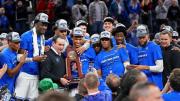Could this be the worst Dunk contest ever, or a sign of the tides changing.
by Andrew Williams

This time of year often brings a level of excitement to my world that can barely be described. This month hold my 3 favorite events I wait for all year. Valentines Day cause the mere over saturation of sappy teddy bears and crème filled chocolates tends to warm my normally cold heart. Second it’s Black History Month a time to celebrate my heritage and understand the sacrifices of my ancestors, but most importantly it’s the month of the All Star break. What a cherished time of year this is. Or it should have been.
All Star weekend often holds a level of mysticism. These giants of the game showcase their talents for the world while on lookers gawk in amazement before running outside in the yard and trying something they just saw their hero preform. Especially with extra legends added to the Diamond 75 year celebration the feel that this was going to best All Star weekend yet. Now the celebrity game gave what it was supposed to give. Myles Garret dunked everything and MGK missed mostly everything but very entertaining nonetheless.
I was even accepting of the 3 point contest demonstrating the new look NBA(Big men you can stretch the floor ). Watching Karl Anthony Towns win the 3 point contest though not traditional it was definitely entertaining. Then came the dunk contest.
Now let me start by saying the dunk contest has always been my favorite part of All Star weekend. I watched a rookie Kobe win in Cleveland, I grew up watching the battle of Air Jordan and the Human Highlight Nique Wilkins. I remember Vince putting his arm on the net. I even tried to emulate Dee Brown’s blind fold dunk. So when I tell you that’s my main event on All Star weekend, I truly mean it. I want to be blown away, I want my mouth to drop like Shaq holding a camcorder in the 90s. After all the Dunk contest usually headlines Saturday’s events, so it should be the best event.
Now going into the event I was not overly excited only one contestant was returning from last year’s contest and that was New York Knicks Obi Toppin ( who finished second to Anfernee Simmons). On the other hand with the likes of Houston Rockets dynamic youngster Jalen Green, Orlando Magics Cole Anthony and Golden State’s Juan Tosano- Anderson rounding out the field it might get interesting quickly. Unfortunately quickly never came.
With a myriad of missed dunk attempts a lot of the mystique was gone. The excitement fizzled to the point Legend Kareem Abdul Jabbar had to excuse himself from such an awful display of dunk ability. Jalen Green was favored to win by Las Vegas book makers but failed to total higher than 85 in the first round. As a matter of fact out all participants in the contest all failed to register a 50 dunk. The winning dunk by Obi Toppin was safe and rather pedestrian and still scored almost 25 total higher than second play Juan Toscano- Anderson. I think the worst part about the dunk contest, the part that I felt was like a taunt from the NBA was watching Ja Morant off an alley-oop gave us “the best and most jaw dropping, oh my goodness, jump out your seat” dunk, and this was during play in ASG.
Maybe once again I am stuck in time where we were not exposed to constant dunking stimulation. We didn’t have professional dunkers post 1 minute clips of the sickest dunks you ever seen. We didn’t have AAU lay up lines looking like LeBron and the Heatles. Maybe I just expected too much, maybe I took Aaron Gordon vs. Zach Levine for granted or maybe, just maybe this year’s dunk contest was trash.
Read more












